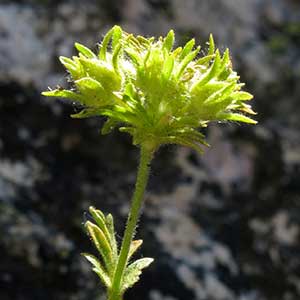Ivesia longibracteata
Ivesia shockleyi
Castle Crags ivesia, longbract mousetail
Shockley's ivesia, sky mousetail
ascending to erect, 0.3–1.2 dm.
prostrate to ascending, 0.2–1.5 dm.
weakly planar to loosely ± cylindric, (0.5–)2–4(–6) cm; sheathing base glandular abaxially, otherwise glabrous;
petiole 0.5–2 cm, hairs 0.2–1 mm;
leaflets 5–6 per side, 2–6 mm, ± short-hirsute, glandular-puberulent, lobes 2–7, oblanceolate to spatulate or obovate, apex not setose.
tightly to loosely cylindric, (1–)2–12(–14) cm; sheathing base strigose to hirsute abaxially;
petiole 0.5–4 cm;
lateral leaflets (3–)5–15(–18) per side, separate to overlapping at least distally, ± flabellate, 1–4(–6) mm, incised to base or nearly so into 2–10(–12) oblanceolate to obovate or elliptic lobes, apex sometimes setose, surfaces ± sparsely hirsute, ± glandular;
terminal leaflets indistinct.
1–3, not paired.
(0–)1;
blade vestigial or reduced.
3–14-flowered, 1–2.5 cm diam.;
glomerules 1.
2–20-flowered, ± open, 0.5–4(–6) cm diam.
1.5–6 mm.
3–10(–12) mm.
8–10 mm diam.;
epicalyx bractlets linear to narrowly lanceolate or elliptic, 2.5–5 mm, longer than sepals;
hypanthium shallowly cupulate, 0.5–1 × 2–3 mm;
sepals 1.5–2.5 mm, ± acute;
petals pale yellow, linear to narrowly oblanceolate, 1.5–2.5 mm;
stamens 5, filaments 0.7–1.3 mm, anthers yellow, 0.5–0.8 mm;
carpels 6–11, styles 1–1.5 mm.
5–10 mm diam.;
epicalyx bractlets 5, elliptic or narrowly oblong to ovate, 0.7–2(–3) mm;
hypanthium patelliform, 1–2 × 2.5–4.5(–5) mm;
sepals 1.5–3.5(–4) mm, acute to obtuse;
petals ± yellow, oblanceolate to spatulate or narrowly obovate, 1–3 mm;
stamens 5, filaments 0.8–1.8 mm, anthers yellow, oblong, 0.4–0.9 mm;
carpels 2–5(–6), styles 1.8–2.5 mm.
cream to light tan, 1.2–1.5 mm.
greenish cream to light brown, 1.5–2.2(–2.5) mm, smooth, prominently carunculate.
Ivesia longibracteata
Ivesia shockleyi
Of conservation concern.
Ivesia longibracteata is known only from the Castle Crags area of Shasta County. The epithet alludes to a diagnostic characteristic unique in the genus: the epicalyx bractlets are longer than the sepals. The plants grow on vertical rock faces, a habitat more characteristic of sect. Setosae; however, the stems are ascending to erect and do not form hanging clumps, and the pedicels are not curved in fruit.
(Discussion copyrighted by Flora of North America; reprinted with permission.)
Varieties 2 (2 in the flora).
(Discussion copyrighted by Flora of North America; reprinted with permission.)
1. Lateral leaflets: lobes 2–5(–7); inflorescences 2–10-flowered, 0.5–3 cm diam.; e California, c, se Oregon, c, n Nevada. | var. shockleyi |
1. Lateral leaflets: lobes (4–)6–10(–12); inflorescences 5–20-flowered, (1–)3–4(–6) cm diam.; wc Utah. | var. ostleri |


